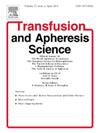在日本进行的一项多中心回顾性调查显示,术前自体献血的不良事件及其在产科患者中的应用
IF 1.2
4区 医学
Q4 HEMATOLOGY
引用次数: 0
摘要
背景评估术前自体献血(PAD)及其输血的安全性是非常重要的,特别是在病毒传播发生率极低的时代,年轻的孕妇献血者。材料与方法向医院发放问卷,收集和分析从献血到输血的安全信息。结果2378例接受PAD的产科献血者中,仅接受自体血的1664例(自体组),接受异体血加自体血的146例(异体组),不输血的568例(不输血组)。2378例患者中有201例(8.5 %)在PAD及其输血过程中出现不良事件(ae),尽管大多数ae是轻微的。即使在不输血组,也有8.1 %的患者出现不良反应。血管迷走神经反应(VVR)率为2.6 % (n = 63)。114例患者(4.8% %)发生了与捐赠相关的其他AE,是所有AE的主要组成部分;32.5 %是产科患者特有的。与其他情况下的PAD供者相比,患有PAD的产科供者可能存在劣势。29例(1.2 %)患者发生输血反应(TRs)。令人惊讶的是,每单位发生TRs的患者数量在自体组和异体组之间没有显著差异。结论考虑到大多数不良事件的发生是由于捐赠,产科患者的PAD是不利的。此外,自体和异体组之间相似的TRs率并不表明自体血液的优先权。PAD应通过完善的输血管理系统进行。本文章由计算机程序翻译,如有差异,请以英文原文为准。
Adverse events during preoperative autologous blood donation and its usage in obstetrical patients: A multicenter, retrospective survey in Japan
Background
Evaluating the safety of preoperative autologous blood donation (PAD) and its transfusion is important, especially for young pregnant donors in an era of extremely low incidence of viral transmission.
Materials and Methods
Questionnaires were sent to hospitals, and safety information from donation to transfusion was collected and analyzed.
Results
Among 2378 obstetrical donors who underwent PAD, 1664 received autologous blood only (autologous group), 146 received allogeneic blood in addition to autologous blood (allogeneic group), and 568 received no transfusion (no transfusion group). Two hundred one of the 2378 patients (8.5 %) experienced adverse events (AEs) during PAD and its transfusion, although most AEs were mild. Even in the no-transfusion group, 8.1 % of patients experienced some AEs. The vasovagal reaction (VVR) rate was 2.6 % (n = 63). Other AE associated with donation developed in 114 patients (4.8 %), and they were the main components of all AEs; 32.5 % of them were unique to obstetric patients. Obstetrical donors with PAD may have disadvantages compared to donors with PAD in other settings. Transfusion reactions (TRs) occurred in 29 (1.2 %) patients. Surprisingly, the number of patients with TRs per unit did not differ significantly between the autologous and allogeneic groups.
Conclusion
Considering that most AEs occurred due to donation, PAD in obstetric patients was not beneficial. Moreover, similar TRs rates between the autologous and allogeneic groups did not indicate the priority of autologous blood. PAD should be performed by using a well-established transfusion management system.
求助全文
通过发布文献求助,成功后即可免费获取论文全文。
去求助
来源期刊
CiteScore
3.60
自引率
5.30%
发文量
181
审稿时长
42 days
期刊介绍:
Transfusion and Apheresis Science brings comprehensive and up-to-date information to physicians and health care professionals involved in the rapidly changing fields of transfusion medicine, hemostasis and apheresis. The journal presents original articles relating to scientific and clinical studies in the areas of immunohematology, transfusion practice, bleeding and thrombotic disorders and both therapeutic and donor apheresis including hematopoietic stem cells. Topics covered include the collection and processing of blood, compatibility testing and guidelines for the use of blood products, as well as screening for and transmission of blood-borne diseases. All areas of apheresis - therapeutic and collection - are also addressed. We would like to specifically encourage allied health professionals in this area to submit manuscripts that relate to improved patient and donor care, technical aspects and educational issues.
Transfusion and Apheresis Science features a "Theme" section which includes, in each issue, a group of papers designed to review a specific topic of current importance in transfusion and hemostasis for the discussion of topical issues specific to apheresis and focuses on the operators'' viewpoint. Another section is "What''s Happening" which provides informal reporting of activities in the field. In addition, brief case reports and Letters to the Editor, as well as reviews of meetings and events of general interest, and a listing of recent patents make the journal a complete source of information for practitioners of transfusion, hemostasis and apheresis science. Immediate dissemination of important information is ensured by the commitment of Transfusion and Apheresis Science to rapid publication of both symposia and submitted papers.

 求助内容:
求助内容: 应助结果提醒方式:
应助结果提醒方式:


